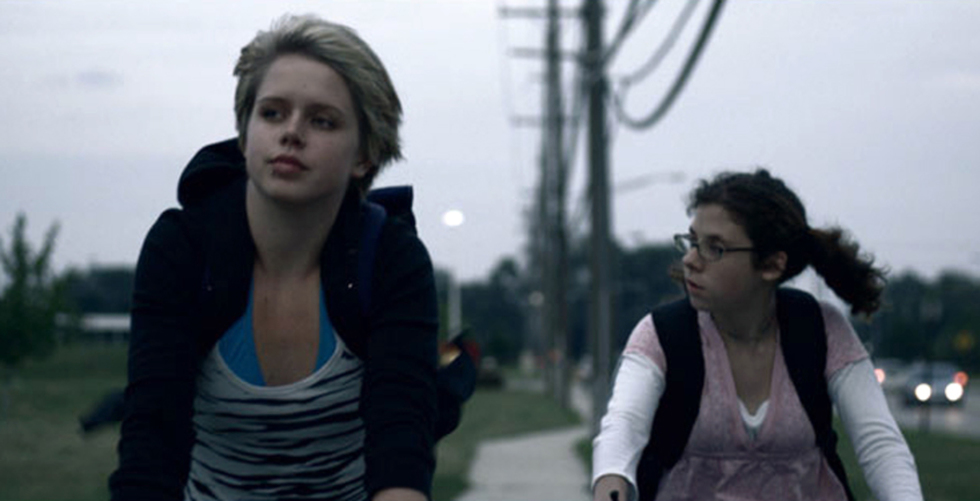
BY ZACHARY WIGON |
The Myth of the American Sleepover
The Myth of the American Sleepover is a lyrical, dreamy paean to the sensation of growing up.


Have you ever wondered what the end result might be if Gus Van Sant remade Dazed and Confused? What about if François Truffaut took a whack at American Graffiti? A teen coming-of-age flick as slow, sweet arty cinema? Well, unfortunately, Truffaut is dead and Van Sant probably isn’t going anywhere near remakes post-Psycho, so instead you’ll have to settle for David Robert Mitchell’s The Myth of the American Sleepover. Drawing on a few different cinematic lineages, from the it-happened-one-night teen-flick variety to the lyrical, languorous vibe of Van Sant’s best work, the film stakes out a stylistic territory entirely its own.
Shot on a low budget with a cast of mainly amateur or inexperienced actors in Michigan, this debut feature stands with a growing group of films (Loren Cass, Tiny Furniture, the recent Bellflower) that demonstrate that just because an indie is made super-cheap doesn’t mean it has to sacrifice aesthetic quality. The Myth of the American Sleepover, shot on the RED camera, has a visual sense that guides the film from start to finish. Light on dialogue and exposition, heavy on tone and atmosphere, the film, which charts what happens to four different young people (three of them teenagers) over the course of the last night of summer, expresses the longings and confusion and excitement of its characters with a perceptive, nuanced visual style. I had the chance recently to speak with Mitchell at the ACE hotel.

Tribeca: The film is obviously dominated by a very gentle, lyrical style. How did that style come to be?
David Robert Mitchell: I think a certain amount of it is just being a huge film buff and being drawn to the kinds of movies that have those kind of moments. I think in the start—I made a lot of short films growing up that were very far from that. By the time I started film school, I had this idea that maybe what’s really important in a story, in a film, are very tiny things that are usually overlooked in movies. When I started film school, that was my goal: to make stuff that focuses on very small things that are very meaningful. Not necessarily life-changing things, but the kinds of things that, over the course of a day, affect us.
Tribeca: I think part of the freshness of the film is that it doesn’t feel the need to be really narrative-driven.
David Robert Mitchell: That’s the point of the movie! Those moments, as opposed to the plot being the point.

Tribeca: And those moments, in your film, are given the kind of narrative importance that in a different film would be given to major plot points. So the film is sort of saying that these little moments that happen over the course of the day are as important to our lives as these big stories that happen over longer periods of time.
David Robert Mitchell: I think that potentially they might even be more important, actually. Those are the things that build our lives. Big things do happen—there are things that are, in positive and negative ways, life-changing—but I think a lot of what builds us, the body of our life, consists of very small things that matter. I was trying to avoid plot, in a way. That was a goal. There were moments when we made the film when I wished I had even less. There’s a part of me that is drawn to the idea of the whole thing being a succession of small experiences, with even less of a conventional story. There are story beats in there, but I tried to mask them.
Tribeca: Dialogue is an easy way to carry a story, and obviously, you eschew that to a degree in this film. Where did your confidence come from in terms of letting dialogue and exposition kind of slide to the wayside?
David Robert Mitchell: I was building moments like that in my short films, and it seemed like it was working, and so I figured, let’s expand this for a feature and see if it works. I believed in myself, but I’d be lying if I said I wasn’t a little bit scared when I set out to do it. I made this plan and followed it, and worked really hard to maintain it.
I love building moments visually. I love placing the audience in a physical space and creating a visceral quality to an environment, to the spaces. I want to make people feel what it is to be there. That happens in some very good films, and I was aiming for that. As for my confidence in doing it—if you’re going to spend years of your life trying to make an hour-and-a-half film, you have to believe in it. That’s a lot of time to spend if you’re doubting yourself!

Tribeca: Movies started out as a silent medium, and personally, I feel like dialogue is sort of an add-on to what makes movies inherently cinematic. Often, I find that the most moving scenes in films have little or no dialogue.
David Robert Mitchell: I love silent film. I’m most proud when I can have sequences that work well with no people talking. The idea of making a silent film is intriguing to me, although I know that was just done at Cannes this year. I was obsessed with—I love Hitchcock, and I love Rear Window. I was obsessed with the Hitchcock/Truffaut book when I was a kid. In junior high, I was obsessed with the idea of point of view. There are a lot of points of view in this film. So much of it is subjective. And I think part of what pulls people in is that subjective point of view. And that plays into something that you can do inherently in film: you can say way more with a few lines of dialogue by having the right kind of reaction to some sort of environment or another character. To me, that’s like gold, when that happens.
Tribeca: Speaking of minimal dialogue, I was reminded of the four experimental Gus Van Sant films—the death trilogy and Paranoid Park—when I saw this. Was that at all an influence?
David Robert Mitchell: I really love his films. I thought Paranoid Park was great. I wasn’t specifically thinking of his films—I don’t think it was a conscious influence—but you see something and it influences you. Someone asked me about Sofia Coppola. I really like her movies, but again, for whatever reason—the idea for this style I’ve sort of had in my head for a really long time. I always saw those movies as being something I connected to, and being something similar to what I hoped to do. But the stuff that I think is the most [influential]—honestly, the French cinema of the ’60s and ’70s. Truffaut’s probably my favorite.

Tribeca: It’s interesting—there aren’t a ton of formally inclined independent American filmmakers right now. And because of the way you use silences and your sense of pacing, I do think of this as a formally progressive film. I don’t know how much your vision was limited by your budget, but it seems to me like a logical progression might be longer takes, long dolly movements, having takes that establish a space with camera movement. Have you thought, in terms of form, where your filmmaking might be headed?
David Robert Mitchell: I would love to try to handle things with less shots, less takes. I like the idea of holding on moments and having some of the work that’s done in editing done on the set instead, with camera movement. This is a very calm movie, there’s very little camera movement. A good amount of that is a stylistic choice. But there would be time where I would’ve liked to move the camera, but I was limited because we were lucky to get the film shot, period. It’s something I want to push myself to add a certain amount of complication to—shooting scenes, to play with the camera more.
For me, there’s a balance—I love a scene that can be one shot, and just a gentle push-in, or not at all, maybe having a certain amount of blocking handle what was done in Myth by cutting to close-ups. I really like that, but I think there can be a balance between that and the close-up. I love the close-up. It’s about how you make a beat work. The beats have to work in a precisely planned way. But if I’m going to push myself, yes, that’s one way to do it.

Tribeca: So, to talk about subjectivity in the film for a moment—a lot of the film’s storyline feels sort of abstracted, like the twin storyline or the scene where the young boy sees his friend’s older sister naked in the bathtub. I didn’t necessarily believe those scenes would happen in real life, but they felt realer than real—they felt like abstractions that expressed a very genuine sentiment that couldn’t be expressed by a realistic depiction of what goes on in these kids’ lives.
David Robert Mitchell: It’s funny, some people have said to me that they felt like the film captures a moment in a very realistic way, and I’d like to believe that there’s a truth in that. I was aiming for a certain amount of naturalism. But I wasn’t trying to make something that was exactly real, either, or completely natural. There is a style to it.
I’ve thought about this recently—looking back on the film, there’s a naturalism that’s sort of dreamlike. I’ve been trying to figure it out, and I guess that’s just something I do. I have some other scripts I want to do, and there’s a comment that kind of recurs—people say, “There’s something dreamlike about this.” I guess I’m drawn to that and it comes across, but it’s not conscious; it’s just what I like.
The Myth of the American Sleepover opens Friday, July 22. Find tickets. It will also be available on demand starting July 27; check your local cable provider.
Watch the trailer: